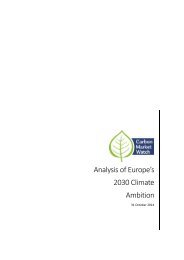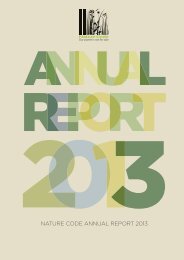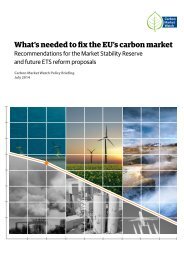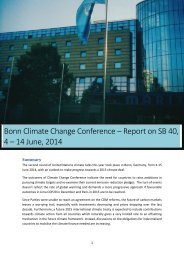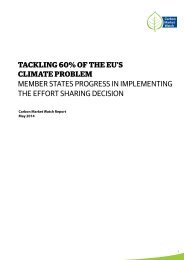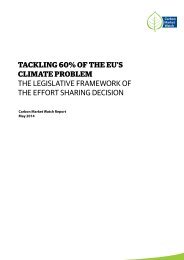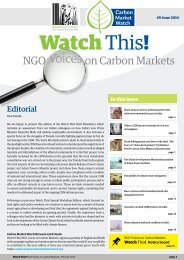Create successful ePaper yourself
Turn your PDF publications into a flip-book with our unique Google optimized e-Paper software.
EXECUTIVE SUMMARY<br />
<strong>The</strong> <strong>Effort</strong> <strong>Sharing</strong> <strong>Decision</strong> (ESD) covers 60% of EU’s total greenhouse gas emissions and is therefore a<br />
centrepiece of Europe’s climate legislation. In contrast to the EU’s Emissions Trading Scheme (ETS) which<br />
started in 2005, the implementation of the ESD only began in 2013. <strong>The</strong>refore, little is known about how<br />
successful it has been tackling the sectors not covered by the ETS.<br />
<strong>The</strong> <strong>Effort</strong> <strong>Sharing</strong> <strong>Decision</strong> establishes linear trajectory of binding emission limits for each Member State<br />
for the 2013-<strong>2020</strong> period and its governance structure is based on annual compliance. According to the first<br />
progress reports from the European Environmental Agency (EEA) (2013), the ESD targets will be overachieved<br />
by up to 50% of the effort required. <strong>The</strong> majority of Member States have therefore not planned significant<br />
additional measures to reduce emissions beyond those that already exist.<br />
Similar to the ETS, the ESD also offers flexibilities and trading options to make it cheaper to comply with the<br />
targets. For example, more than 50% of reduction efforts can be achieved by using international offsets.<br />
Member States have to submit reports on the amount of offsets and other trading options used in 2013 by<br />
January 2016.<br />
<strong>The</strong> current targets, combined with the overgenerous flexibilities, are clearly too weak to drive emission<br />
reductions and delay the implementation of necessary policies for a decade. It is hence no surprise that a<br />
surplus is expected to accumulate in the ESD equal to almost 600 million tons of CO2-eq by <strong>2020</strong>.<br />
Given the importance of reducing emissions in the non-ETS sectors, such as transport, agriculture and<br />
buildings, the lessons learnt with the implementation of the ESD can provide valuable information for<br />
European policymakers for their deliberations regarding the 2030 policy framework for climate and energy.<br />
Recommendations for the 2030 <strong>Effort</strong> <strong>Sharing</strong> <strong>Decision</strong>:<br />
> Strengthen the current governance structure keeping binding emission limits and the<br />
binding annual compliance for each Member State.<br />
> Significantly increase the target to at least 45% emission reductions below 2005 levels by<br />
2030 to fully exploit the cost-effective potential and drive actual emission reductions.<br />
> Do not allow the carry-over of any surplus into the <strong>post</strong>-<strong>2020</strong> period.<br />
> Keep the land use, land-use change and forestry (LULUCF) sector separate from the <strong>Effort</strong><br />
<strong>Sharing</strong> <strong>Decision</strong> and the ETS, without any flexibility options between the different pillars.<br />
> Maintain policies at Union level that contribute to achieving reductions in the non-ETS<br />
sectors inter alia as regards transport and buildings, e.g. ensure the continuation of the Fuel<br />
Quality Directive and establish binding energy efficiency targets.<br />
> Exclude international offsets to meet the 2030 climate obligations.<br />
> Improve the intra-EU flexibilities by establishing harmonized modalities for transactions<br />
between Member States to unlock mitigation potential in poorer Member States, e.g. via<br />
domestic offsetting within the ESD.<br />
2





